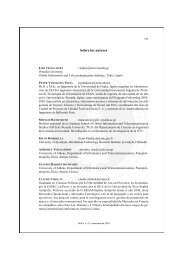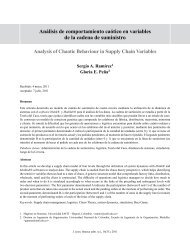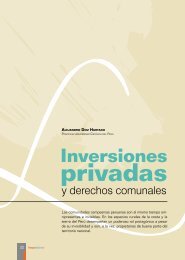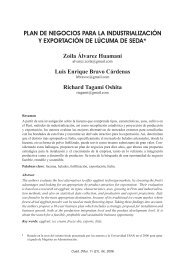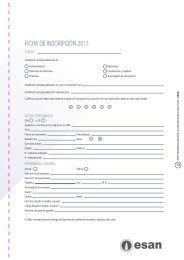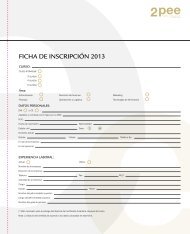re-engineering Agriculture For enhanced Performance ... - SciELO
re-engineering Agriculture For enhanced Performance ... - SciELO
re-engineering Agriculture For enhanced Performance ... - SciELO
Create successful ePaper yourself
Turn your PDF publications into a flip-book with our unique Google optimized e-Paper software.
Vol. 15, Nº 29Mafimisebi, Oguntade & Mafimisebi: Re-Engineering Agricultu<strong>re</strong> for Enhanced <strong>Performance</strong> 39• Federal Government <strong>re</strong>cur<strong>re</strong>nt budget on theagricultural sector (FGRECBA);• Federal Government capital budget on the agriculturalsector (FGCAPBA);• Total volume of loans to the agricultural sector bycommercial and merchant banks (TVLACMB);• Total number of loans guaranteed by theACGSF (TNLGUAD);• Total value of loans guaranteed by the ACGSF(TVLGUAD);• Lending rate to the agricultural sector(LENRAGS in %);• Food importation bill (FOODIMB);• Cumulative number of fully <strong>re</strong>paid loans sinceScheme’s inception (CNFRLSI); and• Cumulative value of fully <strong>re</strong>paid loans sinceScheme’s inception (CVFRLSI).As a first step, the graphs of the key time series we<strong>re</strong>plotted to get a visual <strong>re</strong>p<strong>re</strong>sentation of the movementof the series over time. Owing to information from thegrowing literatu<strong>re</strong> on the characteristics of time-seriesdata especially that <strong>re</strong>lating to non-stationarity, whichleads to spurious <strong>re</strong>g<strong>re</strong>ssion estimates, we first investigatedthe order of stationarity (or econometric integration)using the Dickey Fuller (DF) and the AugmentedDickey Fuller (ADF) class of unit roots test as done byMafimisebi (2002a, 2007, 2008). The DF test is appliedto the <strong>re</strong>g<strong>re</strong>ssion of the form below.ΔP it= β 1+ β 2t+ δP it–1+ l it(4)Δ = first diffe<strong>re</strong>nce operatorP it= variable which series is being investigated forstationarityt = time or t<strong>re</strong>nd variableThe null hypothesis that δ = 0 implies existence of aunit root in P itor that the time series is non-stationary.The number of lagged diffe<strong>re</strong>nce terms in equation 4was inc<strong>re</strong>ased. The DF test is, in this particular case,called the ADF test and equation 4 modifies toΔP it= β 1+ β 2t+ δP it–1+ α 1 Σ ΔP it – 1 + l itmt =1(5)The null hypothesis of a unit root or non-stationarityis still that δ = 0. The critical values a<strong>re</strong> as tabulated byDickey and Fuller (1979), Engle and Yoo (1987) andMackinnon (1990).When a series was found to be non-stationary, itwas first-diffe<strong>re</strong>nced and the ADF test was <strong>re</strong>peated.The time series for all the agricultural c<strong>re</strong>dit-<strong>re</strong>latedvariables included in this study we<strong>re</strong> investigated fortheir order of integration. The maximum number of lagsused in the stationarity test was six (6) and the optimallag for each time-series was selected using the AkaikeInformation Criterion (AIC).Two or mo<strong>re</strong> variables a<strong>re</strong> said to be co- integratedif each is individually non-stationary but the<strong>re</strong> existsa linear combination of the variables that is stationary.Other attributes of co-integration a<strong>re</strong> as shown in Engleand Yoo (1987) and in Silvapulle and Jarasuriya (1994).After the stationarity test, the analysis proceeded bytesting for co-integration between time-series of agriculturalc<strong>re</strong>dit-<strong>re</strong>lated variables that exhibited stationarityof same order.<strong>For</strong> the multiple co-integration test, the maximumlikelihood procedu<strong>re</strong> for co-integration, propoundedby Johansen (1988), Johansen and Juselius (1990,1992) and Juselius (2006), was utilized. Adopting aone-step vector auto-<strong>re</strong>g<strong>re</strong>ssion (VAR) method avoidsthe simultaneity problem characteristic of the Engleand Granger procedu<strong>re</strong> (Baulch, 1995) and allowshypothesis testing on the co-integration vector, r. Themaximum likelihood procedu<strong>re</strong> <strong>re</strong>lies on the <strong>re</strong>lationshipbetween the rank of a matrix and its characteristicroots. The Johansen’s maximal Eigen value and tracetests detect the number of co-integrating vectors thatexists between two or mo<strong>re</strong> time-series that a<strong>re</strong> econometricallyintegrated. The two variable systems we<strong>re</strong>modelled as a VAR as follows:k – 1ΔXt = μ t + Σ Γ i∆X t – 1+ πX t – k+ε ti =1whe<strong>re</strong>:(6)X tis an n x 1 vector containing the series of inte<strong>re</strong>st(time-series of agricultural c<strong>re</strong>dit-<strong>re</strong>lated variables)J. econ. finance adm. sci., 15(29), 2010



